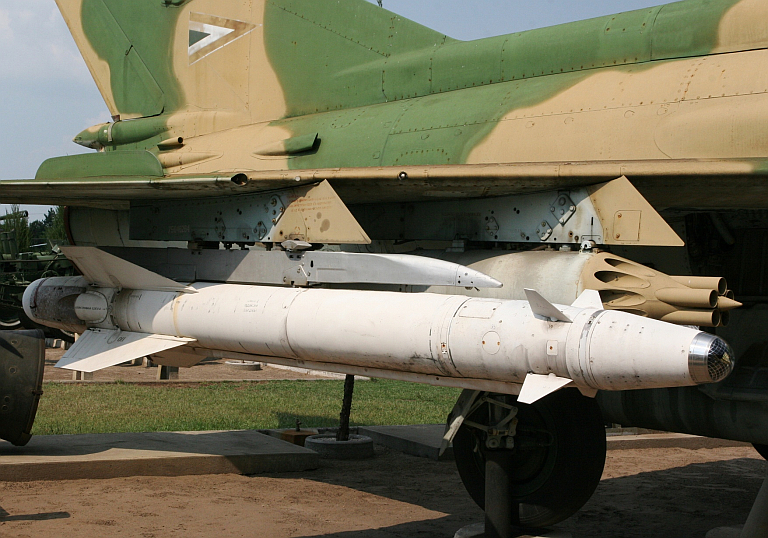|
||||||||||||||||||||||
![Home - Air Power Australia Website [Click for more ...]](APA/APA-Title-Main.png) |
||||||||||||||||||||||
![Sukhoi PAK-FA and Flanker Index Page [Click for more ...]](APA/flanker.png) |
![F-35 Joint Strike Fighter Index Page [Click for more ...]](APA/jsf.png) |
![Weapons Technology Index Page [Click for more ...]](APA/weps.png) |
![News and Media Related Material Index Page [Click for more ...]](APA/media.png) |
|||||||||||||||||||
![Surface to Air Missile Systems / Integrated Air Defence Systems Index Page [Click for more ...]](APA/sams-iads.png) |
![Ballistic Missiles and Missile Defence Page [Click for more ...]](APA/msls-bmd.png) |
![Air Power and National Military Strategy Index Page [Click for more ...]](APA/strategy.png) |
![Military Aviation Historical Topics Index Page [Click for more ...]](APA/history.png)
|
![Intelligence, Surveillance and Reconnaissance and Network Centric Warfare Index Page [Click for more ...]](APA/isr-ncw.png) |
![Information Warfare / Operations and Electronic Warfare Index Page [Click for more ...]](APA/iw.png) |
![Systems and Basic Technology Index Page [Click for more ...]](APA/technology.png) |
![Related Links Index Page [Click for more ...]](APA/links.png) |
|||||||||||||||
![Homepage of Australia's First Online Journal Covering Air Power Issues (ISSN 1832-2433) [Click for more ...]](APA/apa-analyses.png) |
||||||||||||||||||||||
| Last Updated: Mon Jan 27 11:18:09 UTC 2014 | ||||||||||||||||||||||
|
||||||||||||||||||||||
|
Soviet/Russian
Tactical Air to Surface Missiles
Technical Report APA-TR-2009-0804 |
||||||||||||||||||||||||||||||||||||||||||||||||||||||||||||||||||||||||||||||||||||||||||||||||||||||||||||||||||||||||||||||||||||||||||||
| by
Dr Carlo Kopp, AFAIAA, SMIEEE, PEng August 2009 Updated April, 2012 Text © 2009 Carlo Kopp  |
||||||||||||||||||||||||||||||||||||||||||||||||||||||||||||||||||||||||||||||||||||||||||||||||||||||||||||||||||||||||||||||||||||||||||||
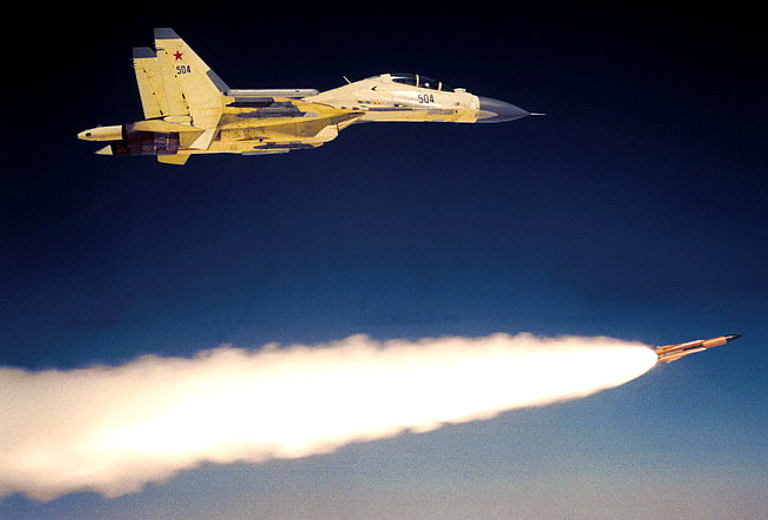 KTRV Kh-31P
/ AS-17 Krypton anti-radiation missile being launched by an Su-30MK
Flanker G (KnAAPO image).
|
||||||||||||||||||||||||||||||||||||||||||||||||||||||||||||||||||||||||||||||||||||||||||||||||||||||||||||||||||||||||||||||||||||||||||||
|
||||||||||||||||||||||||||||||||||||||||||||||||||||||||||||||||||||||||||||||||||||||||||||||||||||||||||||||||||||||||||||||||||||||||||||
BackgroundThe Soviet FA-VVS or tactical
air forces were tasked with providing air support for Soviet land force
formations, and protecting them from hostile air attack. Most of the
guided missiles developed by the Soviets during the Cold War were
developed for Frontal Aviation forces.
In perspective, what is most apparent about Soviet tactical ASM development during this period is the split focus between precision guided missiles intended to bust fortifications and opposing ground forces, and anti-radiation missiles intended to bust NATO air defences. These two categories are the most strongly represented. The technological strategy pursued by the Soviets varies widely. Some weapons are unique Soviet designs, adapted or evolved from other designs, some are unique original, and some like the Kh-58 can only be described as copies of Western equivalents. Contemporary Russian tactical ASMs reflect this heritage, and most use the airframe and propulsion systems of their Soviet predecessors, albeit with incremental technological improvements reflecting two decades of elapsed time. More interesting has been the infusion of digital technology into missile guidance systems, and increasingly, replacement of Soviet era electro-optical and radar technologies in seekers. Many weapons are unique, such as the impressive Kh-31 / AS-17 Krypton, which has evolved into multiple roles. Similar evolution has been seen with the Kh-59M / AS-18 Kazoo, and Kh-25M / AS-10 Karen. The trend for the future is likely to mirror developments in the West, with progressive improvements in seeker technology, especially the introduction of MMWI and focal plane imaging devies, digital guidance, and increasingly, the exploitation of satellite navigation technology to enhance existing munitions. 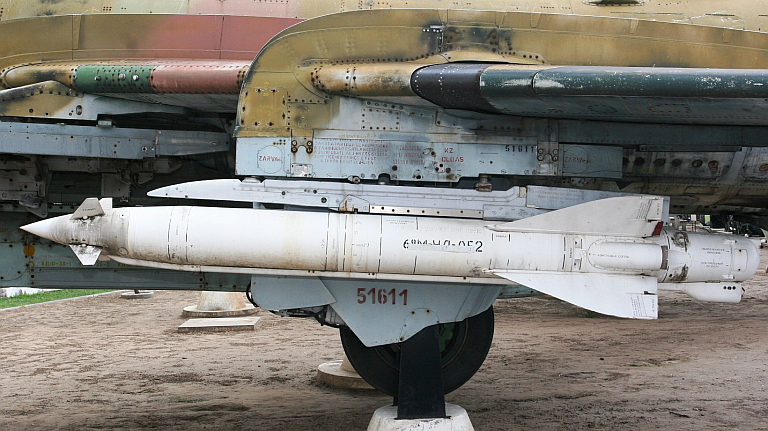 The Kh-23 / AS-7 Kerry was an equivalent to the AGM-12 Bullpup and led to the development of the Kh-25 Karen/Kegler family of weapons. This example is on display at Kecel in Hungary (© 2009, Miroslav Gyűrösi). Technical Note #1:The Soviet military industrial complex was scattered across virtually all republics which had a well developed industrial base, and many which did not. Key manuafacturers of missile components, especially guidance systems and subsystems, were located across the RSFSR (Russia), the Ukraine and Belarus. After the fall of the Soviet Union, this collaboration continued by necessity. A major upheaval developed in 2004 when the Ukraine split away and was effectively embargoed by the Russians, resulting in the loss of key capabilities in both design and manufacture, which were located in the Ukraine.Many are being reconstituted in Russia, for instance Geofizika is re-establishing production of infrared missile seeker technology previously manufactured by Arsenal in the Ukraine, who are now effectively bankrupt as Russia is no longer purchasing their seekers for use in AA-11 Archer missile production. In tactical guided weapons the principal impact was produced by the loss of the Lviv based Tekon/Elektron, which designed and manufactured the Tubus-2 series stabilised television seekers used in the Kh-29TE / AS-14 Kedge, Kh-59 Ovod / AS-13 Kingbolt, Kh-59M Ovod M / AS-18 Kazoo and key components of the associated APK-9E datalink pod. It is not clear whether the Russians will attempt to reconstitute this capability, or develop entirely new replacement products. In this respect the global transition from thermionic imagers to CCDs may well dictate new designs, but none have been reported as yet. Belorussia's Peleng is offering a replacement TV seeker design. |
||||||||||||||||||||||||||||||||||||||||||||||||||||||||||||||||||||||||||||||||||||||||||||||||||||||||||||||||||||||||||||||||||||||||||||
Tactical Air Surface Missiles |
||||||||||||||||||||||||||||||||||||||||||||||||||||||||||||||||||||||||||||||||||||||||||||||||||||||||||||||||||||||||||||||||||||||||||||
S-25L/LD/IRS/TV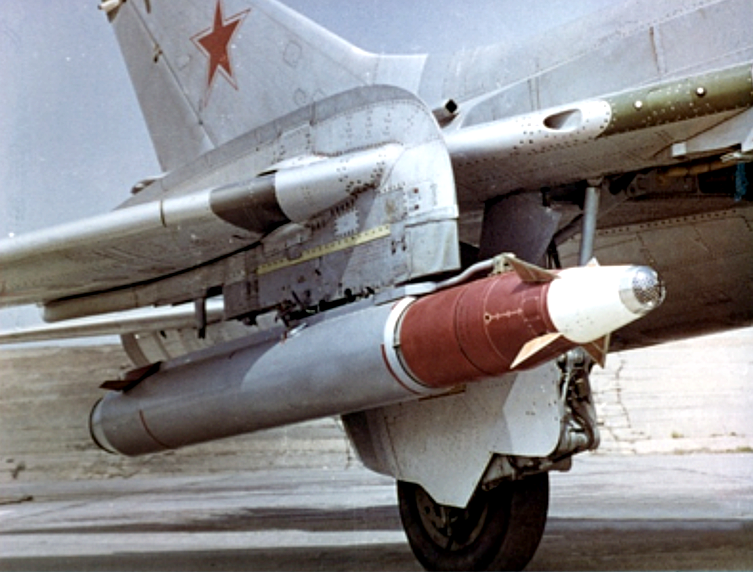 The KB Tochmash / Nudelman
S-25L series are large calibre tube launched 400 kg folding fin
rockets, with terminal guidance seekers to provide a precision weapon
for close air support and battlefield interdiction operations.
The basic unguided S-25 rocket is designed to self stabilise by rotating about its axis at 600 RPM, using canted tail fins to impart the rotation. This weapon achieved IOC with the FA-VVS in 1979. A 150 kg penetrator warhead is used with a 21 kg shaped charge precursor warhead. The guided variants retain this arrangement, with the seeker section on the nose attached the weapon fuselage by a low friction bearing, decoupling the seeker from the fuselage rotation. Two basic variants exist, the S-25L and improved S-25LD, both with the KBT 24N1 gimballed semiactive laser homing seeker used in a number of other weapons. KBT have also adapted other seeker hardware and developed an infrared homing seeker variant, the S-25IRS, and a television seeker equipped variant, the S-25TV. Phazotron have also offered an active radar homing seeker for the weapon.
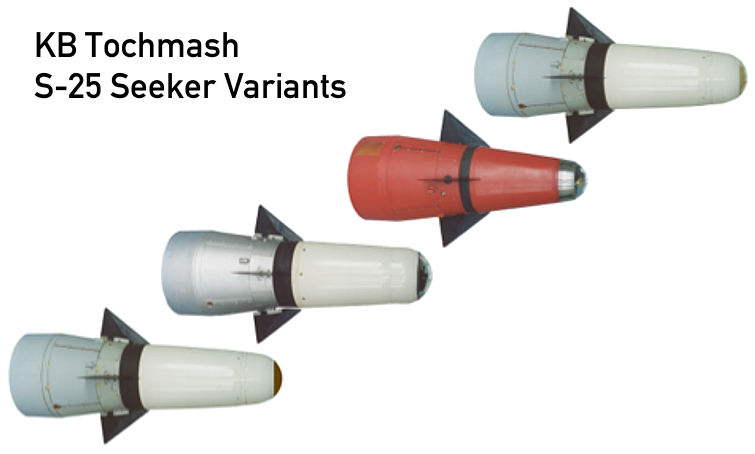 |
||||||||||||||||||||||||||||||||||||||||||||||||||||||||||||||||||||||||||||||||||||||||||||||||||||||||||||||||||||||||||||||||||||||||||||
Kh-25 / AS-10 Karen / AS-12 Kegler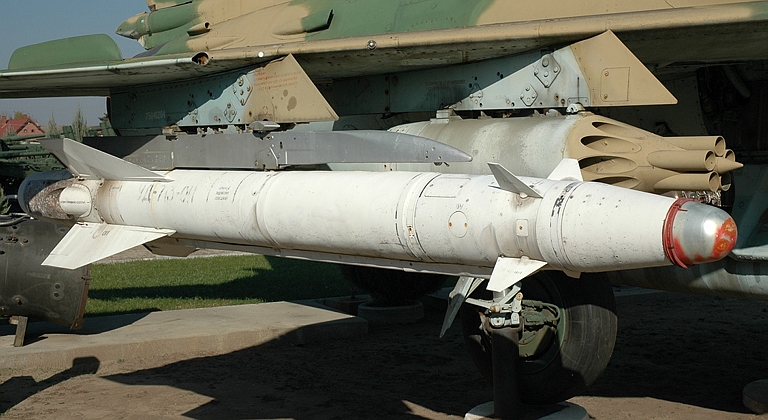 The laser guided Kh-25L/ML is one of the
most widely used close air support weapons in the Russian inventory
(Wikipedia image).
The versatile Kh-25 / AS-10
Karen family of missiles was developed to replace the earlier
Kh-23/Kh-66 / AS-7 Kerry, itself developed as a counterpart to the US
AGM-12 Bullpup series. Like the Bullpup the Kh-23/Kh-66 suffered
persistent difficulties with its cumbersome radiofrequency guidance
system.
The Kh-25M / AS-10 Karen was designed around the model of interchangeable homing seekers, making it a defacto equivalent to the ubiquitous US Hughes (now Raytheon) AGM-65 Maverick missile. The missile uses canard controls driven by a common SUR-73 guidance and control module. The PRD-276 solid rocket motor exhaust is via paired nozzles on the aft fuselage, permitting the installation of a tail antenna aperture for datalink equipped variants. The motor has a two phase boost/sustain burn profile. Known Kh-25 variants are listed in the following table:
Production Kh-25 variants are detailed further: Kh-25ML / AS-10 Karen
|
||||||||||||||||||||||||||||||||||||||||||||||||||||||||||||||||||||||||||||||||||||||||||||||||||||||||||||||||||||||||||||||||||||||||||||
| Основные тактико-технические характеристики Х-25МЛ | |
| Дальность пуска, км | 3-10 |
| Максимальная скорость полёта, м/с | 870 |
| Стартовая масса, кг | до 310 |
| Масса боевой части, кг | 86 |
| Длина ракеты, м | 3,705 |
| Диаметр ракеты, м | 0,275 |
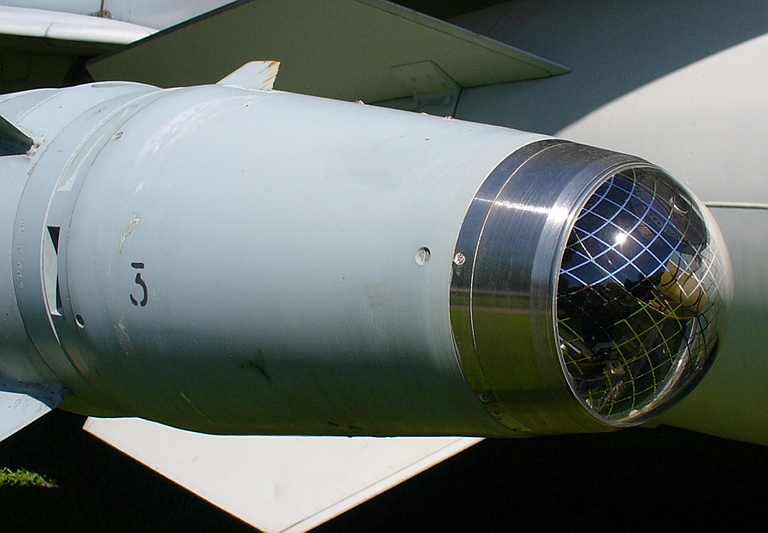
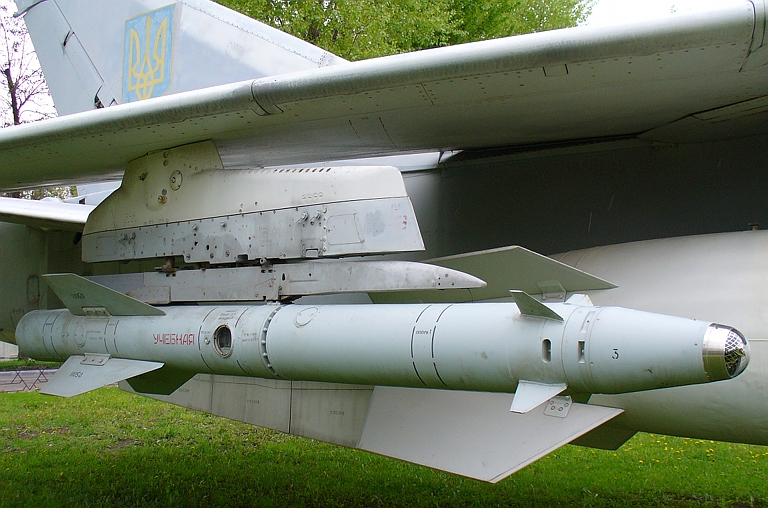
Kh-25MAE / AS-10 Karen
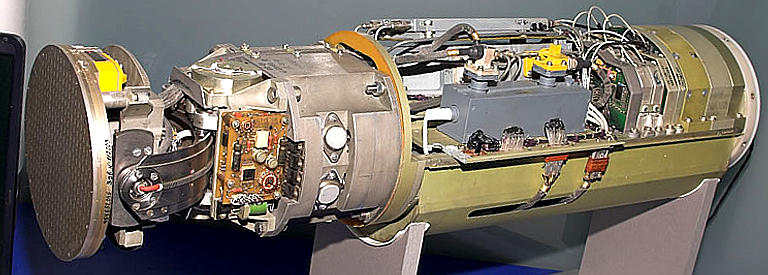
Phazotron
PSM-E series Ku-band MMW active radar seeker developed for the Kh-25MAE
(via Missiles.ru).
The Kh-25MAE variant employs an
inertial navigation system and an unspecified active radar seeker, it
is intended for attacks on a wide range of surface targets including
vehicles, parked aircraft, helicopters, C3 targets, POL targets and
structures, under day, night and adverse weather conditions.
The seeker is
an MMWI Ka-band design, the PSM-E developed by Phazotron, and is
comparable to the seeker in the US AGM-114L MMW Hellfire
variants, but with a narrower antenna scan angle and larger aperture.
The manufacturer has published numerous discussion notes
extolling the virtues of MMW seekers for this specific application.
| Основные тактико-технические характеристики Х-25МАЭ | |
| Дальность применения, км |
2,5 ... 40 |
| Диапазон высот пуска, м |
50... 12000 |
| Максимальная скорость полета ракеты, м/с |
920 |
| Боевая часть, тип | фугасная или проникающая |
| Масса БЧ, кг |
не более 90 |
| Стартовая масса ракеты, кг |
до 330 |
| Габаритные размеры, м |
|
| длина |
4,406 |
| диаметр корпуса |
0,275 |
| размах крыла |
0,755 |
| ТЕХНИЧЕСКИЕ
ХАРАКТЕРИСТИКИ ФАЗОТРОН-НИИР АРГС ПСМ-Э |
|
| Диапазон
волн |
Ка |
| Дальность
обнаружения целей — танк, км: |
4 |
| Дальность
обнаружения целей — промышленное здание, км: |
5…8 |
| Сектор
обзора — по азимуту, град. |
±
30 |
| Сектор обзора — по углу места, град. | ±
20 |
| Точность
измерения — дальности, м: |
8…10 |
| Точность
измерения — скорости, м/с: |
0,5 |
| Масса,
кг |
не
более 16 |
| Время
подготовки, с |
60 |
| Source: Missiles.ru |
|
Kh-25MSE / AS-10 Karen
| Основные тактико-технические характеристики Х-25МСЭ | |
| Дальность пуска, км | до 40 |
| Диапазон высот пуска, м | 50 ... 12 000 |
| Максимальная скорость полета, м/с | 920 |
| Боевая часть, тип | фугасная или проникающая |
| Масса БЧ, кг | не более 90 |
| Стартовая масса, кг | до 323 |
| Габаритные размеры, м: | |
| длина | 4,355 |
| диаметр корпуса | 0,275 |
| размах крыльев | 0,755 |
Kh-25MP / AS-12 Kegler
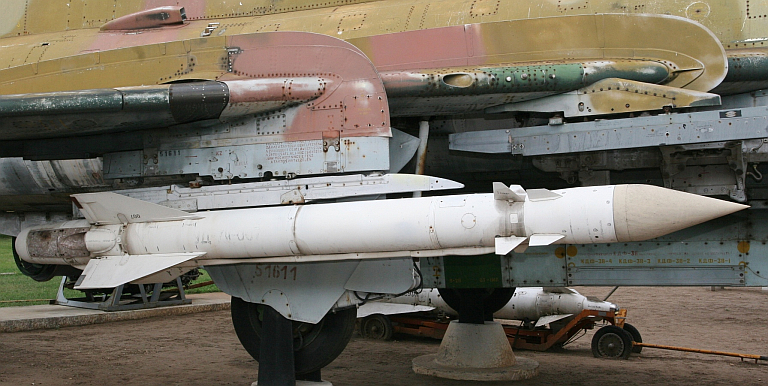
The missile is equipped with a band specific PRGS-1VP or PRGS-2VP anti-radiation homing seeker. Post launch the missile seeker is programmed to climb along a logarithmic trajectory until the seeker depression angle to the target emitter is 27º, at which point the missile pitches down, transitions to terminal homing in azimuth and elevation, and dives into the target emitter.
The Kh-25 is typically operated in an LOBL
regime, with the seeker capable of autonomous search while being
carried on the APU-68 or APU-68UM launcher. The PRGS-1VP searches a 60º
angular sector in azimuth for threat emitters, and once locked can
track the emitter at a rate of up to 6º/s. The PRGS-2VP can track the
emitter at a rate of up to 8º/s, through elevation angles of +20º to
-40º.
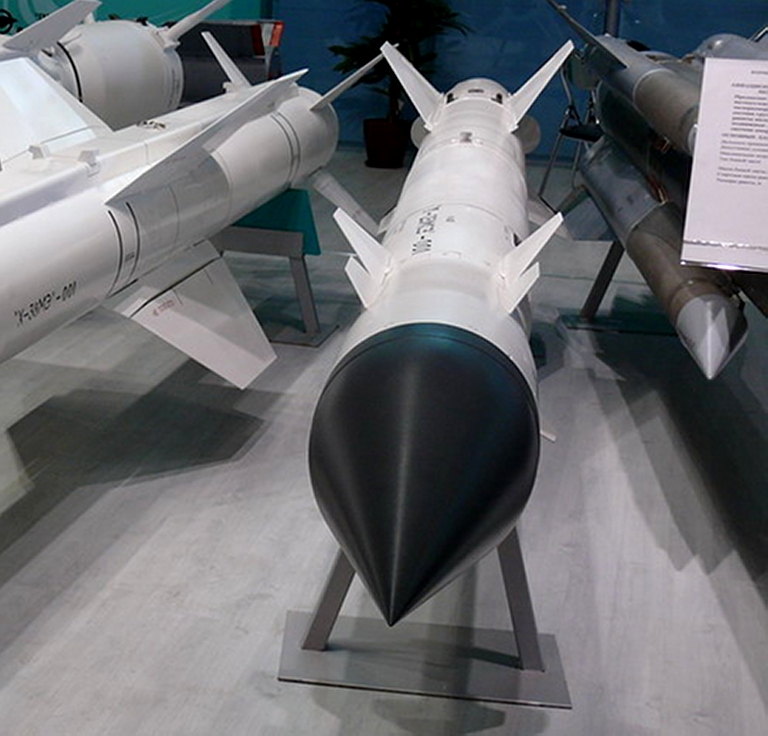
Kh-25MP / AS-12 Kegler anti-radiation missile (image Said Aminov).
| Основные тактико-технические характеристики Х-25МП | |
| Дальность пуска, км | не менее 40 |
| Максимальная скорость полёта, м/с | 920 |
| Стартовая масса, кг | до 330 |
| Масса боевой части, кг | 86-90 |
| Длина ракеты, м | 3,705 |
| Диаметр ракеты, м | 0,275 |
Kh-28 / AS-9 Kyle
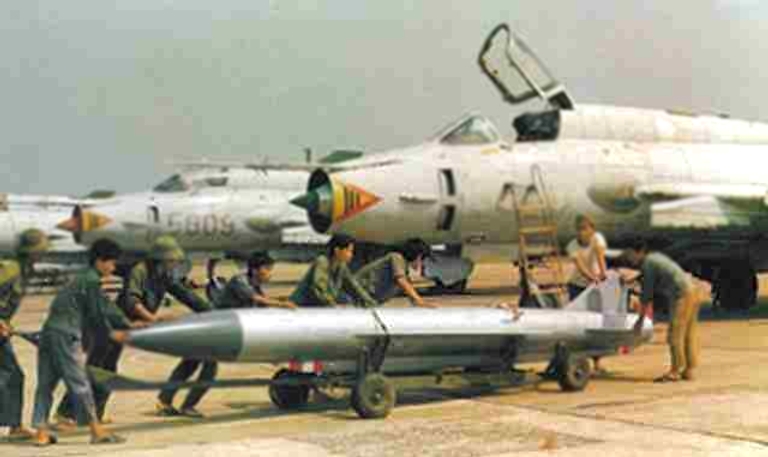
The Raduga Kh-28 / AS-9 Kyle was the first specialised high performance anti-radiation missile built by the Soviets, with development initiated during 1963. The intended launch platform was the Yak-28 Brewer, used by Frontal Aviation as an electronic combat aircraft.
The design of the new missile was based on Raduga's much larger Kh-22 / AS-4 Kitchen and KSR-5 / AS-6 Kingfish. The result of the decision to build the weapon as a scaled down derivative of existing liquid fuelled missiles was an unusually complex and densely packed design, which used the R-253-300 engine used in the KSR-5, using the toxic, corrosive and difficult to handle AK-20F/TG-02 hypergolic fuel mix. The Avtomatika PRG-28 anti-radiation seeker also proved troublesome to develop, and band specific variants were produced to defeat specific NATO SAM systems.
The missile entered service during the 1970s, but was too heavy for the underpowered Yak-28 Brewer, and was redeployed on the Su-17M Fitter and Su-24 Fencer which had the performance to carry a pair of these missiles. The ventral stabiliser prevented carriage under the fuselage. The weapon was targeted using a podded Metel A/B homing receiver on the Fitter or Flogger, or the internal Filin N homing receiver in the Fencer.
While the missile was fast and long ranging, it was complex and difficult to maintain, and quickly superceded by the newer and easier to maintain solid propellant Kh-58 missile. The Kh-28 was exported to Iraq and Syria but it is not known whether either were able to successfully operate it.
| Основные
тактико-технические характеристики Х-28 |
|
| Длина, мм | 5970 (6040) |
| Максимальный диаметр фюзеляжа, мм | 430 |
| Размах крыла, мм | 1930 |
| Стартовый вес ракеты, кг | 690 (715) |
| Вес фугасной боевой части 9А283,кг | 140 |
| Дальность
стрельбы, км - по проекту - с высоты 5км - с малых высот |
90-110 (120) 70 25-45 |
| Скорость полета, м/с | 800 |
| Высота применения, м | 200-11000 |
| Круговое вероятное отклонение, м | 20 |
| Вероятность попадания в цель | 0.8 |
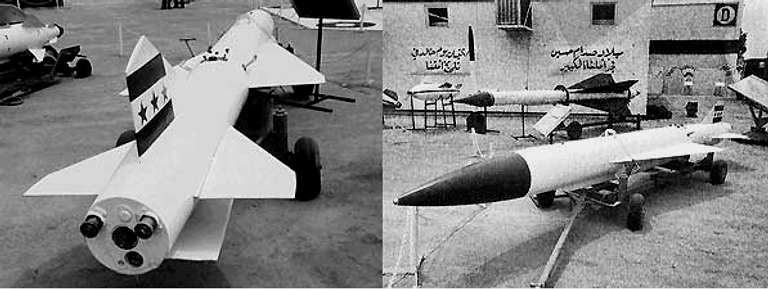
Iraqi propaganda images of Kh-28 missile, painted in non-standard livery.
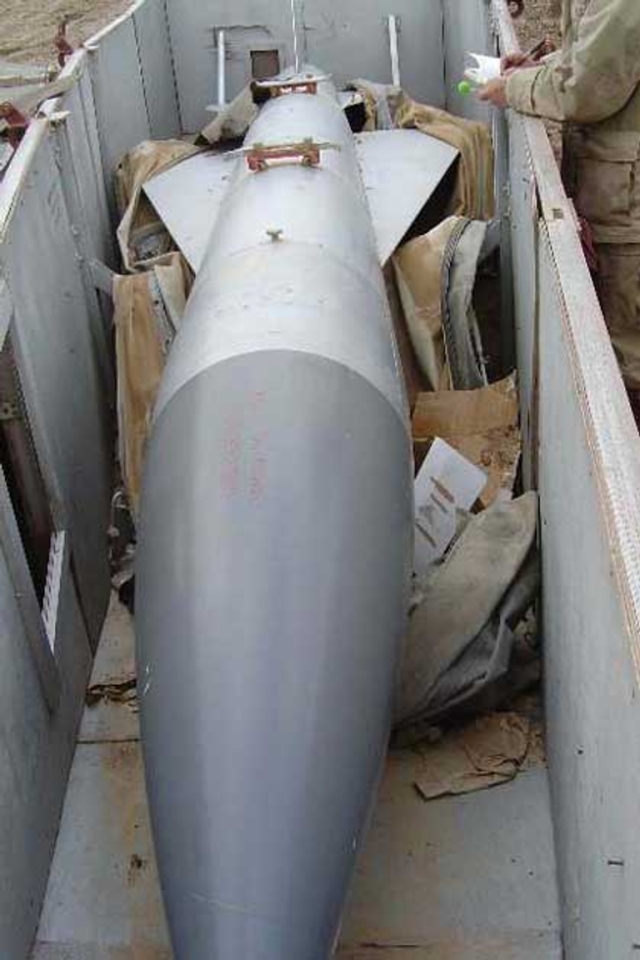
Captured Iraqi Kh-28 in 2003 (US DoD).
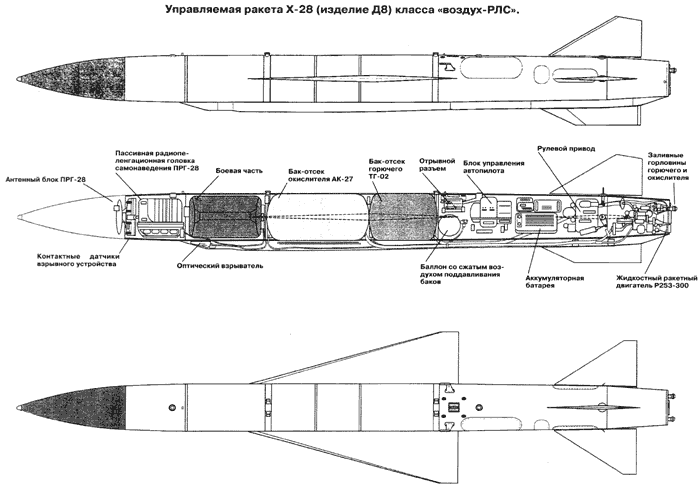
Kh-29TE/L/D / AS-14 Kedge
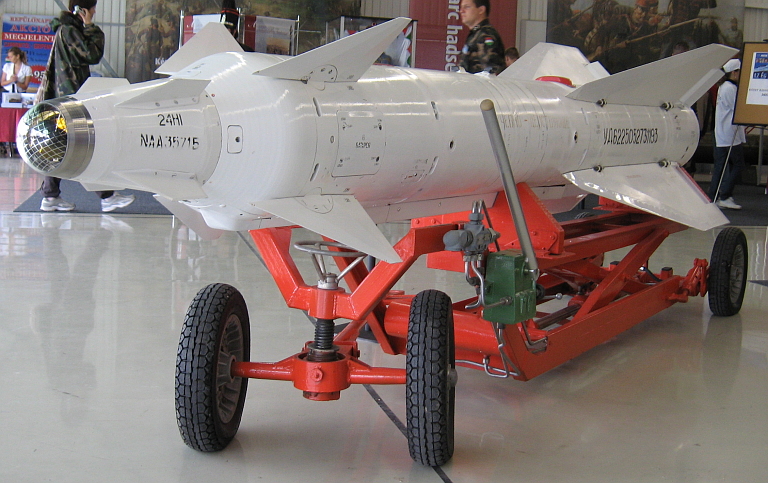
Vympel Kh-29 Kedge ASM (Wikipedia image).
The Vympel Kh-29 / AS-14 Kedge is a Russian supersonic equivalent to the French AS.30
and US AGM-65 Maverick, and is primarily intended for interdiction and
close air support, maritime strike roles, and attacks on hardened
concrete shelters and structures. An APU-58 or AKU-58
launcher is used, on the Su-27/30 Flanker (up to 6 rounds), the MiG-27
Flogger (2 rounds), Su-17/22 Fitter (2 rounds) and Su-24M Fencer (3
round). Multiple variants exist.
The Kh-29L (Izdeliye 63 or
AS-14A) is a semi-active laser
homing variant used in the manner of the AS.30L, with a 24N1
seeker.
The Kh-29T (Izdeliye 64 or AS-14B) is an electro-optical variant with a
daylitgh television seeker. The Kh-29TE
is the export variant, the Kh-29TM an enhanced variant. The Kh-29TD is
another EO variant, possibly equipped with
a thermal imaging seeker.
Launch
weight for most variants is around 1,500 lb, with a 700 lb warhead
being used most often. Range is usually cited at 16 nautical miles for
a high altitude launch.
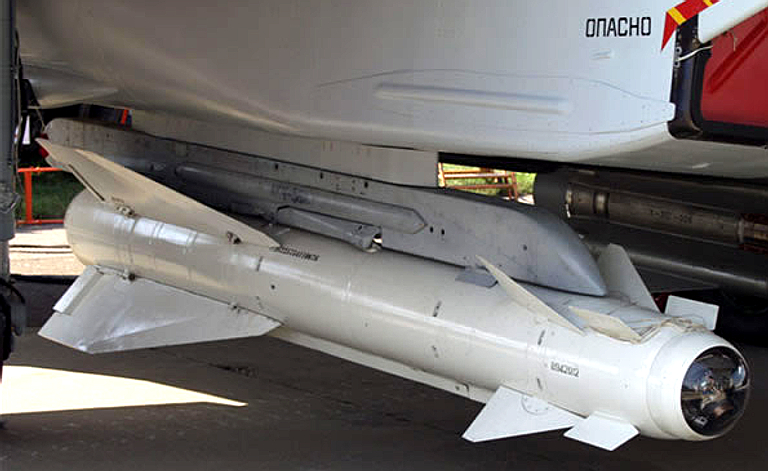
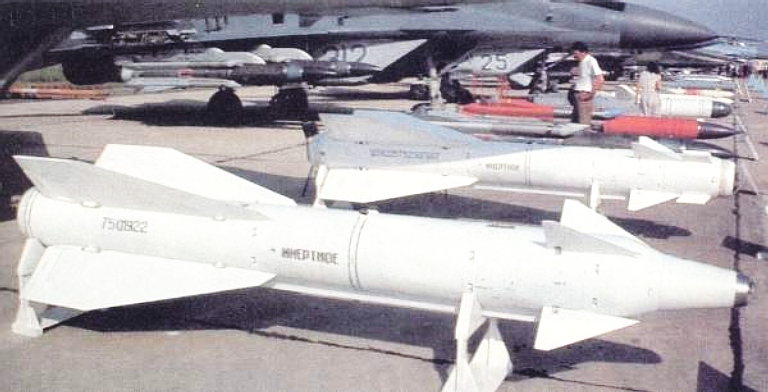
| Основные ТТХ | Х-29ТЕ |
Х-29Л |
| Дальность пуска: | ||
| максимальная, км | 20-30 |
10 |
| минимальная, км | 3 |
3 |
| Стартовая масса, кг | 690 |
660 |
| Масса боевой части, кг | 320 | |
| вес взрывчатого вещества, кг | 116 | |
| Высота пуска, км | 0,2-5 | |
| Максимальная скорость полета, м/с | 600 | |
| Средняя скорость полета, м/с | 250-350 | |
| Габаритные размеры, м | ||
| длина | 3,9 | |
| диаметр | 0,4 | |
| размах крыльев | 1,1 | |
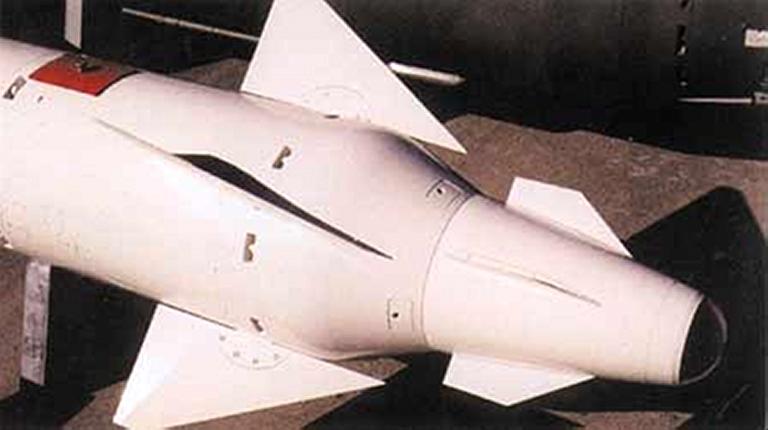
Kh-29L
semi-active laser homing seeker.
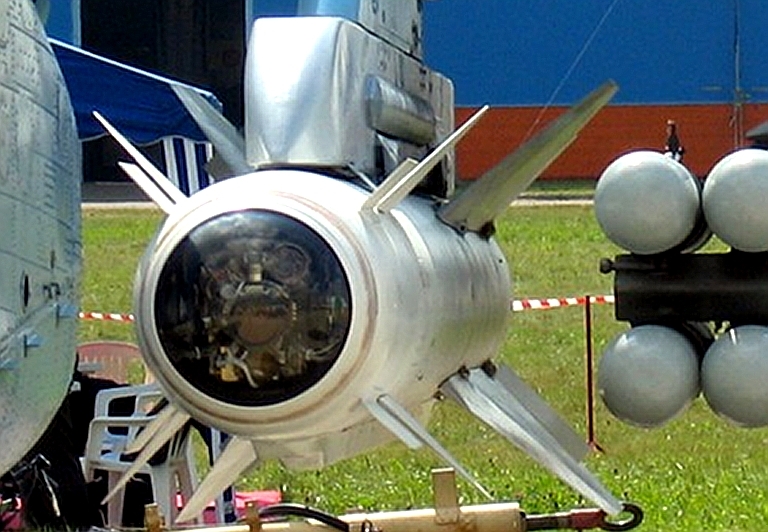
Kh-29T T-2 series daylight television seeker.
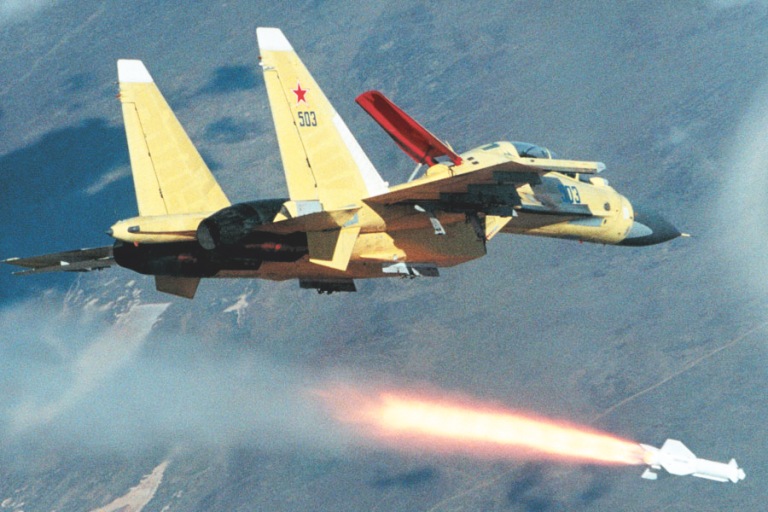
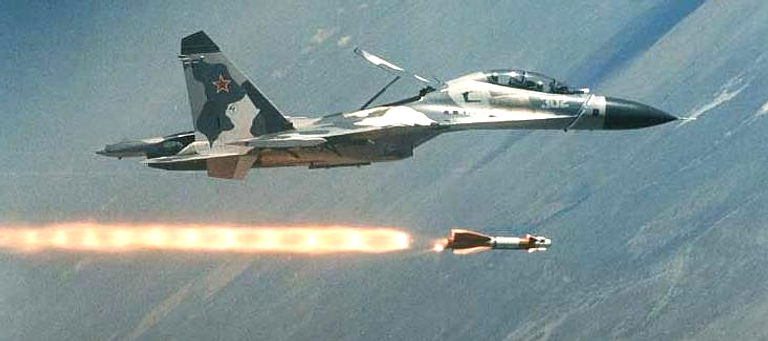
Kh-31P/PK/PD/A/AD / AS-17 Krypton

The Mach 4.5 ramjet Kh-31 / AS-17 Krypton family of missiles includes anti-radiation, anti-shipping and claimed anti-AWACS variants. Reports claim the PRC intends to licence build this weapon, depicted with an Su-30KN prototype (KNAAPO).
Dubbed the 'Mini-Moskit', the
supersonic Turayev ramjet
powered Kh-31P (AS-17 Krypton) was originally designed as an
anti-radiation missile to suppress NATO Patriot and I-Hawk batteries,
entering use in 1988.
The powerplant arrangement uses a
solid rocket booster in the tail to accelerate the vehicle to ramjet
ignition speed. Once the propellant is expended, the booster cavity is
employed as a combustor cavity for the kerosene fuelled ramjet which is
used to continue accelerating the missile to cruise speed and then
sustain that speed until the liquid fuel is expended.
The missile's combination of high
speed, small size and long range makes it a challenging target to
intercept by air defences.
At altitude the Kh-31 achieves Mach 4.5, as sea level Mach 2.7. Su-30MK fitted for the Kh-31 series carry up to six rounds on wing stations 3, 4, 11, 12 and inlet stations 9 and 10, using AKU-58 adaptors, the Su-27SKU four rounds on 3, 4, 9 and 10.
It has no equivalent in the
Western inventory, the US Navy
using it as the MA-31 target drone. The PLA is reported to use this
weapon with recent claims of plans for licence production as the YJ-91
series.
During the 1990s there were persistent claims that the airframe was being adapted for use as a long range AAM with a Counter-ISR role, as an “AWACS-killer”, with the designation R-31P. The reality is that both the anti-radiation and anti-shipping variants of the extended range configurations of this missile have compatible 135 NMI plus range on high altitude trajectories, and suitable basic seeker technology, and both have a suitable laser proximity fuse. Adaptation for an air - air role of this kind would involve primarily changes to the control laws in the guidance and proximity fusing timing parameters. It is entirely conceivable that such a Counter-ISR capability already exists embedded in newer variants of the missile's guidance system.
Variants of this weapon are
detailed thus:
Kh-31P / AS-17 Krypton
The Kh-31P is the basic anti-radiation variant of the missile with a band specific Avtomatika L-111E family interferometric seeker, which uses an array of seven cavity back spiral antennas on a gimballed platform. The seeker can home on pulsed or CW emitters.
| Основные тактико-технические характеристики Х-31П | |
| Дальность пуска, км | 15-110 |
| Максимальная скорость на траектории, м/с | 1000 |
| Стартовая масса, кг | 600 |
| Масса боевой части, кг | 87 |
| Длина ракеты, м | 4,7 |
| Диаметр ракеты, м | 0,36 |
Kh-31PK / AS-17 Krypton
| Основные
тактико-технические характеристики Х-31ПК |
|
| Диапазон дальностей пуска, км | 15... 110 |
| Диапазон высот пуска, м | 100... 15000 |
| Диапазон скоростей пуска, км/ч (М) | 650...
1250 (0,65 <М< 1,5) |
| Стартовая масса ракеты, кг | 605±10 |
| Габаритные
размеры (длина х диаметр корпуса х размах крыла), м |
4,8x0,36x0,914 |
Kh-31PD / AS-17 Krypton
The Kh-31PD is a stretched
extended range variant of the basic
design. There are claims that this variant exploited work performed by
Boeing on adapting the Kh-31 as the MA-31 target. Cited range of this
variant is more than twice that of the basic missile, using an improved
31DP ramjet and increased fuel tankage. The design
employs an improved TsKBA Omsk Avtomatika L-130 wideband seeker, likely
providing coverage between
1 to 11 GHz.
A 110 kg submunition dispensing
warhead is optional.
| Основные тактико-технические характеристики Х-31ПД | ||
| Максимальная
дальность пуска (параметры полета носителя: Н=15 км, М=1,5), км |
180-250 | |
| Минимальная
дальность пуска (Н=0,1 км), км |
15 |
|
| Диапазон
высот пуска, км |
0,1-15 | |
| Диапазон
скоростей пуска (число М) |
0,65-1,5 | |
| Система
наведения |
инерциальная + широкодиапазонная пассивная радиолокационная ГСН | |
| Угол пеленга цели в момент пуска, градус: | ||
| -
захват цели под носителем |
±15° | |
| -
захват цели на траектории |
±30° | |
| Тип боевой части | кассетная, универсальная | |
| Масса
боевой части, кг |
110 | |
| Топливо
|
керосин | |
| Стартовая масса ракеты (не более), кг | 715 | |
| Длина х диаметр х размах крыла (руля) ракеты, м: | 5,340 х 0,360 х 0,954 (1,102) | |
| Носители | Су-30МК (МКИ, МКМ, МК2), Су-35, МиГ-29К, МиГ-29КУБ, МиГ-35 и др. | |
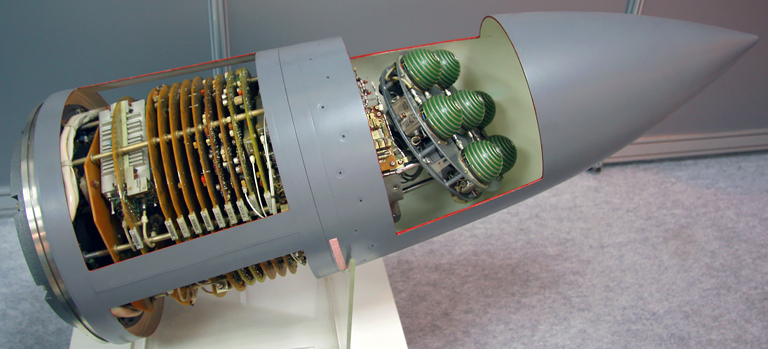
| ТЕХНИЧЕСКИЕ
ХАРАКТЕРИСТИКИ Л-112Э |
|
| Диапазоны частот поражаемых РЛС | D...F |
| Чувствительность приемника ГСН, дБ/ мВТ | 60 |
| Поиск и захват цели под носителем по данным целеуказания или автономно | |
| Масса аппаратуры ГСН, кг | 23 |
| Габариты отсека, мм диаметр длина |
360 1065 |
| Состояние | серийное производство |
Kh-31A / AS-17 Krypton
Russian sources claim the weapon has been exported to China, India and Vietnam.
The seeker can be locked onto the target before launch, or acquire the target post launch, to maximise operational flexibility.
Kh-31AD / AS-17 Krypton
| Х-31А | Х-31АД | |
| Разработчик | ОКБ "Звезда" | Корпорация "Тактическое ракетное вооружение" |
| Изготовитель | ГНЦП "Звезда-Стрела" | Корпорация "Тактическое ракетное вооружение" |
| Дальность
действия,км: - максимальная по целям типа "эсминец" - максимальная по целям типа "ракетный катер" - минимальная |
50 25 5-7 |
120-160 км параметры полета носителя: (Н=15 км, М=1,5) |
| Скорость
полета,м/с: - максимальная - средняя |
1000 600-700 |
1000 600-700 |
| Скорость полета носителя ,км/ч | 600-1100 | 0,65-1,5 (число М) |
| Высота пуска,км | 0.05-15 (0.1-10) | 0,1-15 |
| Габариты,мм:
- длина - максимальный диаметр корпуса - размах крыльев - размах рулей |
4700 360 778 1005 |
5310 360 778 1005 |
| Стартовый вес ,кг | 600-610 | 715 |
| Вес боевой части,кг | 90-95,9 | 110 |
| Активная радиолокационная ГСН АРГС-31 | ||
| Разработчик | холдинг "Ленинец" | холдинг "Ленинец" |
| Угол азимутального обзора, град | 40 | до ± 27° |
| Угол вертикального обзора,град | от +10 до -20 | от +10 до -20 |
| Вес, кг | 39 | 39 |
| Диаметр, мм | 360 | 360 |
| Длина, мм | 1012 | 1012 |
| Температура использования | от -50° до +50°С | от -50° до +50°С |
| Авиационная пусковая установка АКУ-58 | ||
| Разработчик | МКБ "Вымпел" | |
| Вес пустой ПУ, кг | 185 | |
| Габариты,мм:
- длина - ширина - высота |
3810 130 220 |
|
| Носители | самолеты Су-30МК (МКИ, МКМ, МК2), Су-35, МиГ-29К, МиГ-29КУБ, МиГ-35 и др. | |
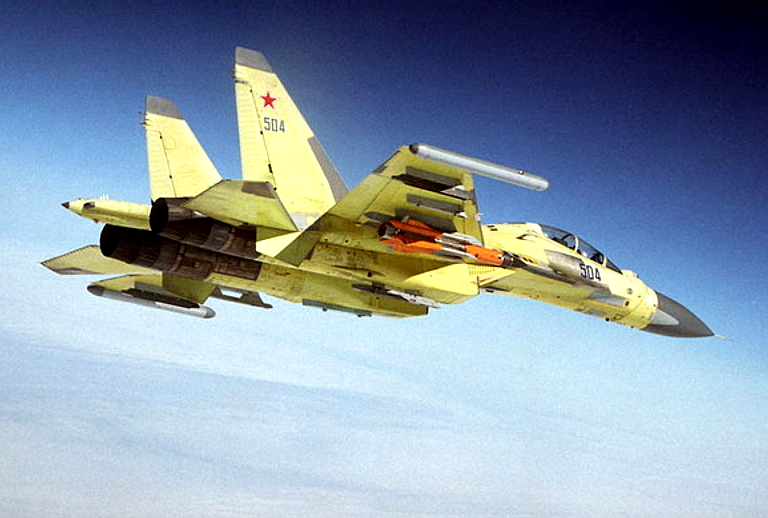
Kh-38MLE/MAE/MTE/MKE
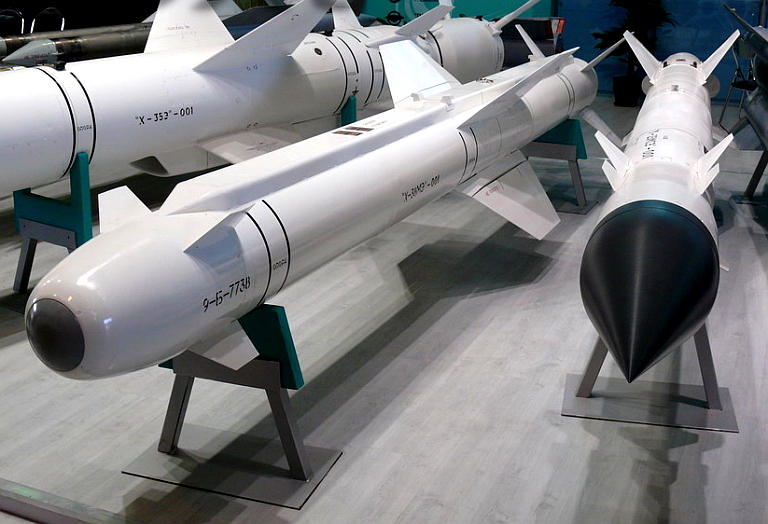
The weapon is being offered in a range of distinct variants:
- Kh-38MLE with inertial midcourse and semi active laser terminal homing guidance.
- Kh-38MAE with inertial midcourse and active radar terminal homing guidance.
- Kh-38MTE with inertial midcourse and thermal imaging terminal homing guidance.
- Kh-38MKE with satellite aided inertial midcourse guidance.
| Основные тактико-технические характеристики | |
| Дальность пуска, км | 3
- 40 |
| Скорость полета, число М, не более | 2,2 |
| Угол
пеленга цели в горизонтальной плоскости в момент пуска, градус |
±80° |
| Вероятность
поражения цели (без противодействия/при противодействии) |
0,8/0,6 |
| Срок службы, лет | 10 |
| Назначенный
ресурс (самолет/вертолет): |
|
| по взлетам-посадкам, шт. | 15/30 |
| по налету под носителем, ч | 75/75 |
| по наработке аппаратуры, ч | 90/90 |
| Масса боевой части, кг | до
250 |
| Взрывательное устройство | контактное |
| Двигатель | Двухрежимный
ракетный двигатель твердого
топлива (РДТТ) |
| Стартовая масса ракеты, кг, не более | 520 |
| Длина х диаметр корпуса х размах крыла ракеты, м | 4,2х0,31х1,14 |
| Носители | самолеты,
вертолеты |
| Размещение ракет | на
авиационных пусковых устройствах АКУ
или АПУ |
| Условия
пуска: |
|
| диапазон высот пуска, м | 200-12000 |
| диапазон скоростей пуска, м/с | 15-450 |
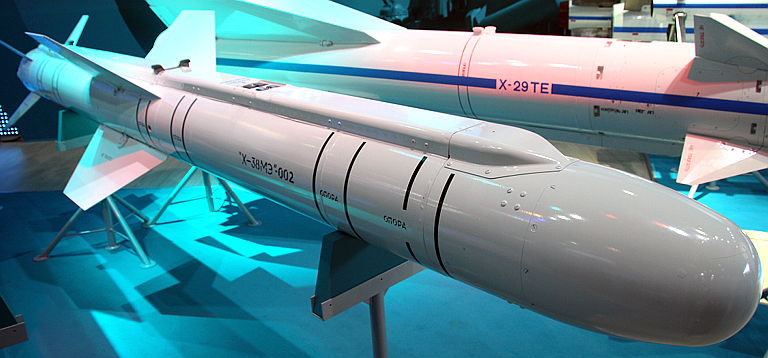
Kh-38ME
mockups on display at MAKS 2009, with radar and EO seekers. Note the
folding wings for compact or internal carriage (© 2009 Vitaliy V.
Kuzmin).
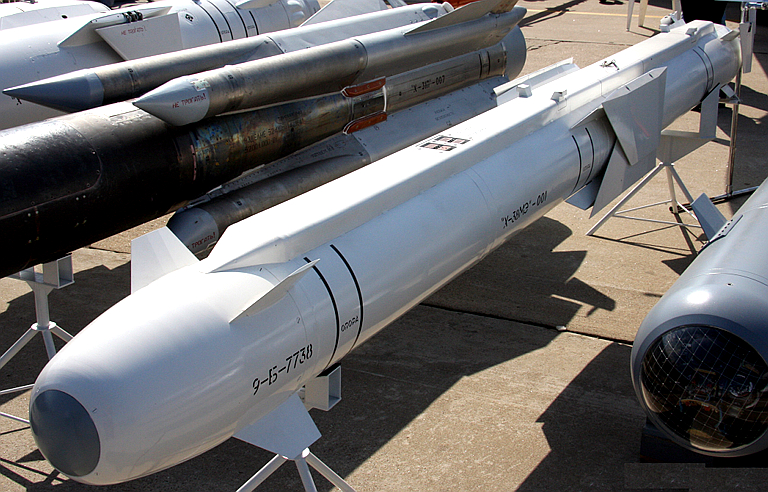
Kh-58E/U/Kh-58UShKE / AS-11 Kilter
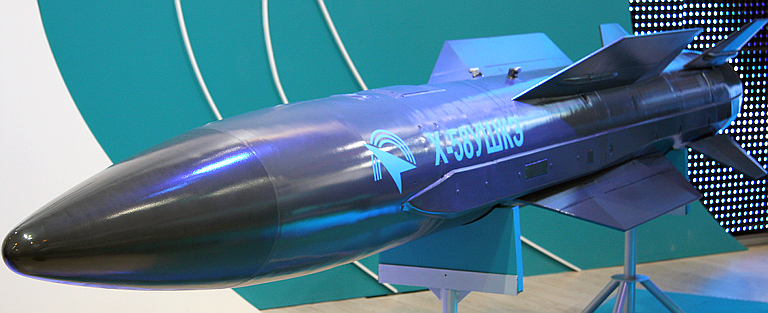
The Kh-58 airframe uses 30KhGSA stainless steel extensively, and OT4-1 titanium alloy is employed for the wings and tail surfaces. The Avtomatika PRGS-58 anti-radiation homing seeker is mounted in the nose, its generates steering signals for the SAU-58 guidance, which also uses inertial unit inputs for midcourse guidance. The 149 kg blast-fragmentation warhead employs an ROV-20 active laser proximity fuse with a backup contact fuse, both armed by the guidance unit. The rocket motor develops 6,000 kp of thrust during the initial boost/climb phase, and once this 3.6 sec burn is completed the sustain phase thrust rating of 1,000 kp is produced until burnout.
The Kh-58 can be carried externally using the AKU-58 launcher, or internally using the UKVU-50 ejector.
In a typical delivery profile the missile flies a semi-ballistic trajectory on inertial guidance, switching to passive anti-radiation homing as it nears the target emitter.
A number of distinct variants exist.
The baseline Kh-58 introduced during the Cold War had a cited range of up to 120 km.
It was replaced by the improved Kh-58U which had a better PGS-58M seeker and a range of up to 250 km for a high altitude supersonic launch.
The current production Kh-58E export variant has a range of 200 km, subject to launch conditions, and likely employs the engine developed for the Kh-58U. The weapon has been integrated on the new MiG-31BM Foxhound variant.
An anti-shipping variant equipped with an active radar seeker and analogous to the Matra-BAe Sea Eagle has been proposed.
The latest export variant offered is the Kh-58UShKE, which is slightly shorter than the Kh-58E, uses shorter span wings, and has a range of up to 245 km. It is equipped with a new wideband seeker design capable of acquiring emitters operating between 1.2 and 11 GHz, and can also home on CW (continuous wave) emitters in one band.
| Основные тактико-технические характеристики | Х-58Э | Х-58УШКЭ |
| Максимальная
дальность, км (в зависимости от высоты при максимальной скорости пуска) |
46…200 | 76…245 |
| Диапазон высот пуска, м | 200…20000 | 200…20000 |
| Максимальная скорость полета ракеты км/час | 4,200 |
4,200 |
| Диапазон скоростей пуска | соответствует числу М=0,47…2,35 | 0,47…1,5 |
| Стартовая масса, кг | 650 | 650 |
| Масса боевой части, кг | 149 | 149 |
| Габаритные размеры, м |
||
| длина | 4,8 | 4,19 |
| размах крыла | 1,17 | 0,8 |
| диаметр | 0,38 | 0,38 |
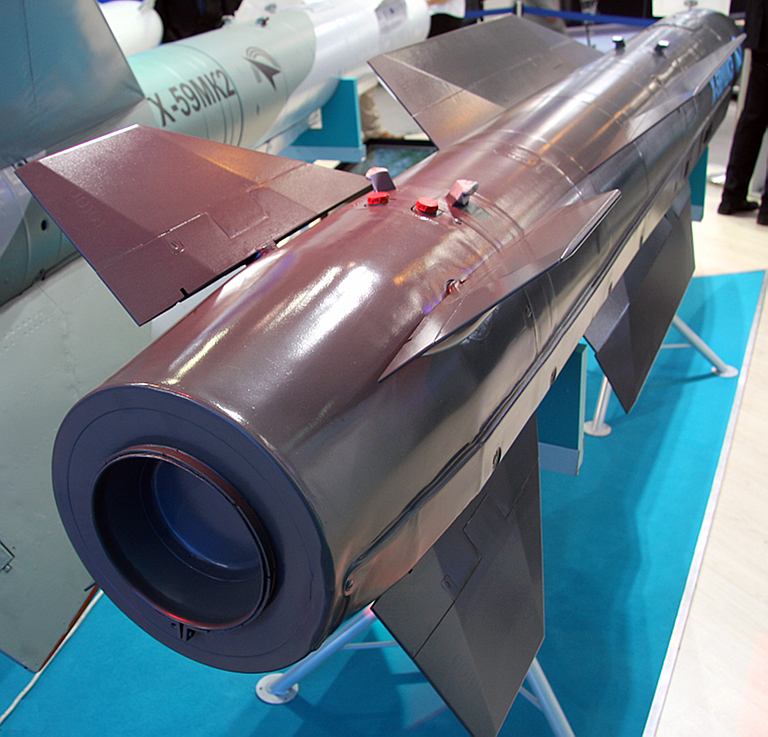
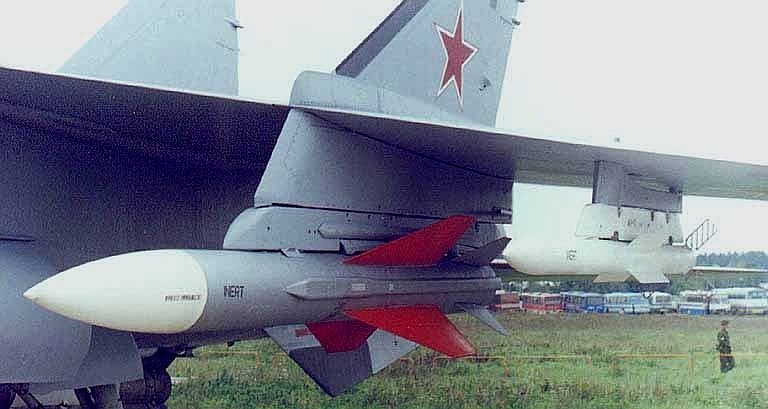
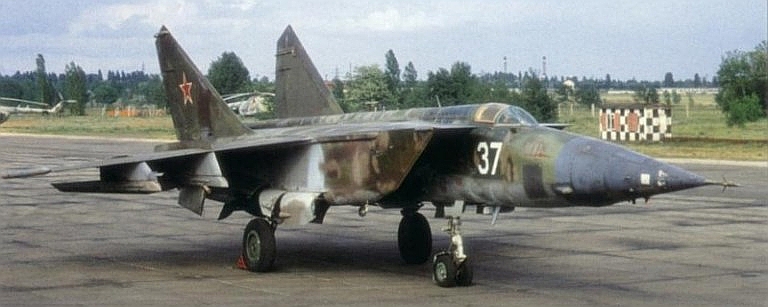
Foxbat
F.
The Soviet answer to the Wild Weasel F-4G, the Foxbat F is essentially
a Foxbat D fitted with a radar homing system to support four AS-11
Kilter ARMs. With high dash speeds the Foxbat F can punch through a CAP
barrier and fire its ARMs before defending fighters can reengage, and
in the high density European theatre envisaged in the eighties, it was
a potentially very useful asset.
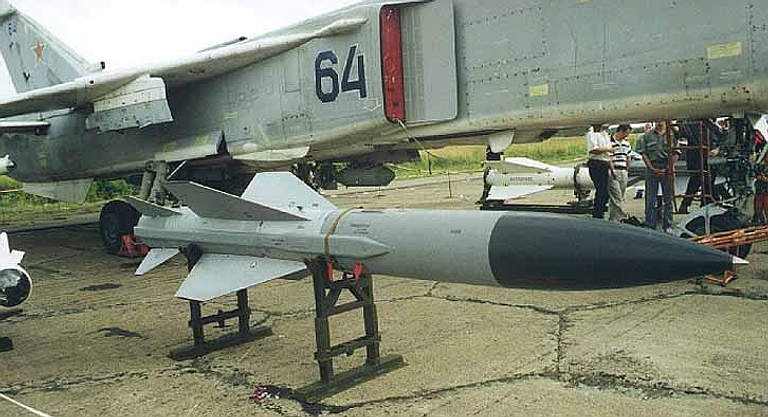
Kh-58
and Su-24M Fencer.
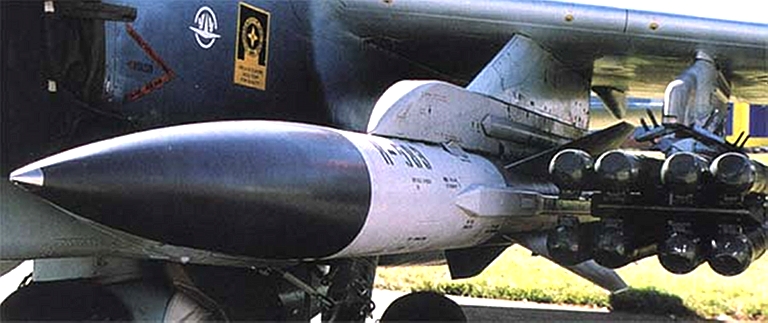
Kh-58
carried by Su-25 Frogfoot.
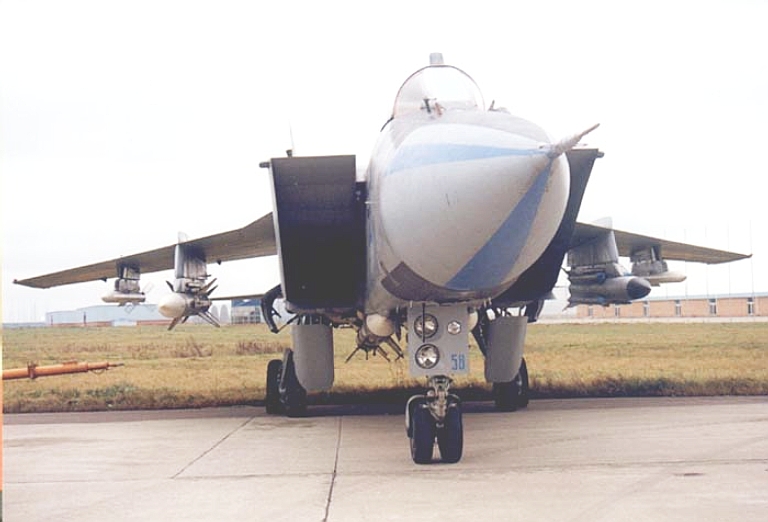
MiG-31F
Foxhound demonstrator with Kh-58U under left wing and Kh-31P under
right wing. This design is the basis for the current digital MiG-31BM
variant.
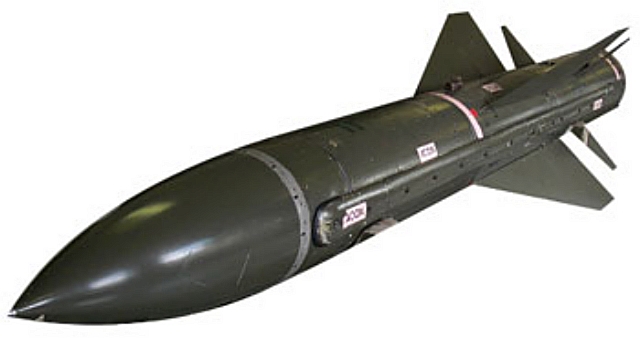
Kh-59 Ovod / AS-13 Kingbolt
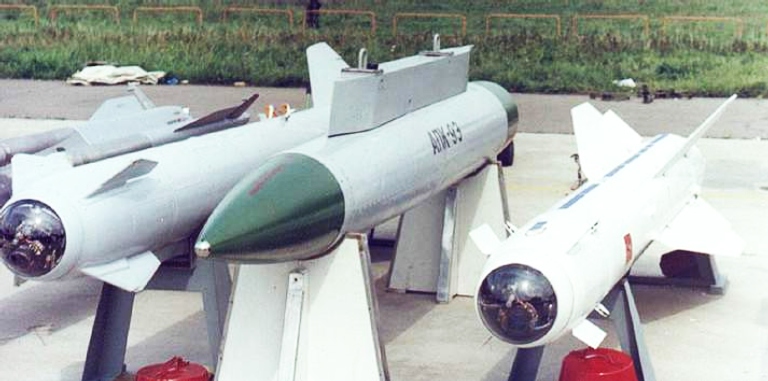
Initial development envisaged a television and datalink guided weapon similar to the HS-Matra TV Martel, using the Kh-58 / AS-11 Kilter airframe and Kh-29TE Tekon-Elektron Tubus-2 / Granit 7T-M1 television seeker system, but this idea was abandoned due to the long range high speed high altitude profile airframe and propulsion optimisation of the Kh-58. The new missile needed to perform better at lower altitudes and speeds, and provide a range of at least 40 km.
The subsonic missile design employs two solid rockets for propulsion, a tail booster, and a fuselage sustainer with a pair of nozzles exhausting from the sides of the fuselage. Once the booster burns out it is jettisoned, exposing the radome for the missile datalink, which carries TV imagery to the launch aircraft and receives operator steering commands, both using the Raduga APK-9E Tekon pod. Missile control is effected by trailed edge surfaces in the cruciform tail, with distinct folding canards used for stability. The missile airframe is constructed with stainless steel and light alloys. An AKU-58-1 launcher is used.
The Raduga APK-9E Tekon pod employs a number of key components no longer built by Tekon-Elektron in the Ukraine. These include the X-band 1DV1-401AMK pulse mode command uplink transceiver and its gimballed and stabilised antennas, the SB-1A solid state FMCW analogue TV downlink transceiver, the PK-9M pod and the IT-23M cockpit display for the system.
The principal launch vehicle for the Kh-59 is the Su-24M Fencer.
| Тактико-техническая характеристика Х-59 | |
| Дальность стрельбы ,км | 40 |
| Точность стрельбы (КВО), м | 2-3 |
| Скорость полета, м/с | 285 |
| Длина ракеты, мм | 5368 - 5370 |
| Максимальный диаметр корпуса ракеты, мм | 380 |
| Размах крыльев , мм | 1260 (1170) |
| Стартовый вес ,кг | 760-790 |
|
Авиационная пусковая
установка
|
|
| Тип | АКУ-58 |
| Число ракет на ПУ | 1 |
| Разработчик | МКБ "Вымпел" |
| Вес пустой ПУ, кг | 185 |
| Длина ПУ, мм | 3810 |
| Ширина ПУ, мм | 130 |
| Высота ПУ, мм | 220 |
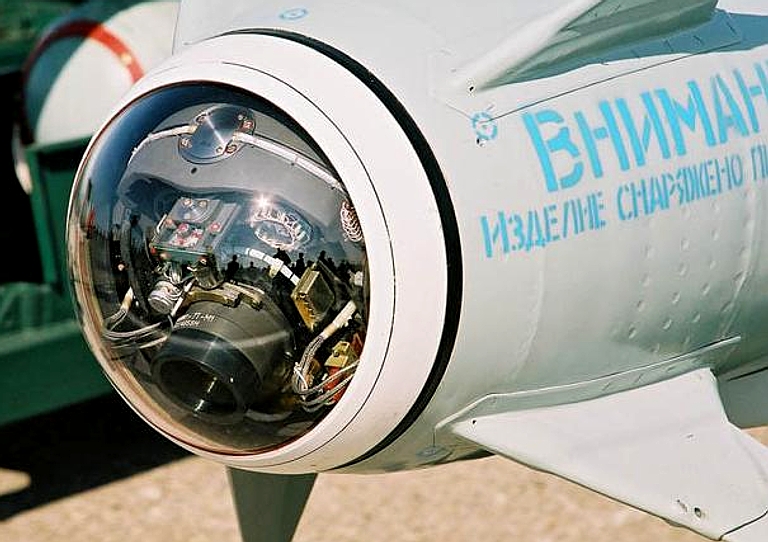
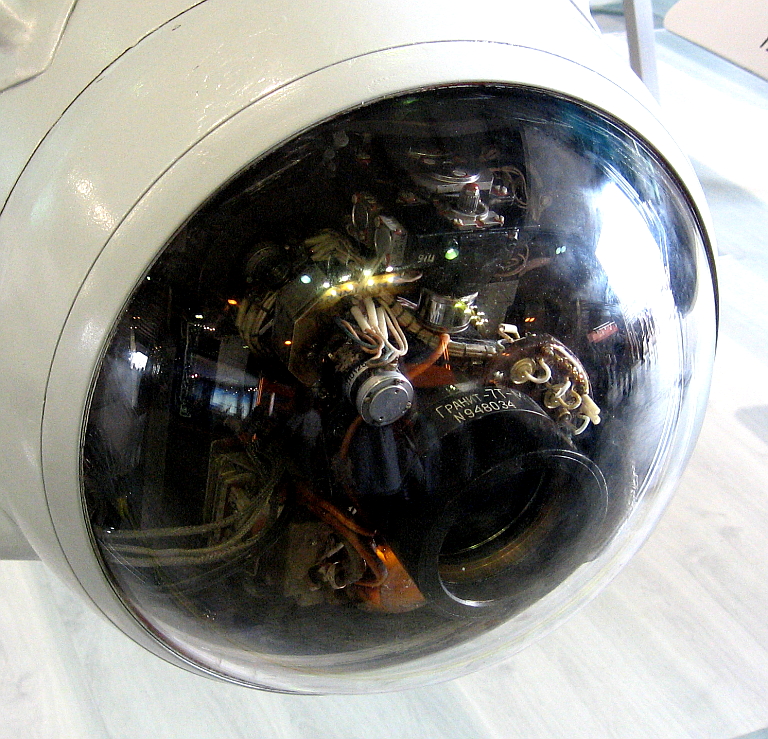
Kh-59ME/M2E Ovod-M/M2E / AS-18 Kazoo

The 2,000 lb (920 kg) 62 NMI (115
km) range Kh-59M/D (AS-18
Kazoo) series stand-off weapon evolved from the earlier rocket powered
Kh-59 / AS-13 Kingbolt missile.
It shares the common
Tekon-Elektron Tubus 2 / Granit 7T-M1
optical seeker
and Raduga / Tekon-Elektron APK-9 Tekon series DL pod with the
earlier weapon.
The most prominent design change is the installation of a ventral RDK-300 turbojet sustainer in a pod similar to the design in the Kh-55 cruise missile, replacing the rocket sustainer and its side mounted exhaust nozzles. The autopilot can be programmed for clearance altitudes of 50, 100, 200, 600 or 1000 m AGL, or 7 m AMSL. The missile is fitted with a KTRV-Detal 3A-81G radar altimeter, similar to the design used in the 3M80 / SS-N-22 Sunburn.
The weapon has been widely
exported to arm Flanker variants. The Su-27SKM/30MK fitted for the
Kh-59M/MK2 carry two rounds on
wing stations 3 and 4, using AKU-58 adaptors, the pod carried on inlet
station 9.
The APK-9 series datalink pod is
4 metres long, has a diameter of 0.45 m, weighs 260 kg, and has a range
of 140 km using nose and tail mounted antennas.
The Raduga APK-9E Tekon pod employs a number of key components no longer built by Tekon-Elektron in the Ukraine. These include the X-band 1DV1-401AMK pulse mode command uplink transceiver and its gimballed and stabilised antennas, the SB-1A solid state FMCW analogue TV downlink transceiver, the PK-9M pod and the IT-23M cockpit display for the system.
A number of distinct variants
have been developed since this weapon was introduced to FA-VVS units
during the late 1980s.
The Kh-59M2E is an improved variant with a stated night attack capability, although whether this was achieved by installing a low light capable CCD imager or by a complete optical system replacement with a gimballed thermal imager has not been disclosed to date. Claimed CEP is ~2-3 metres. The improved APK-9ME pod is used. It is likely that both the seeker and datalink pod designs for this variant are substantially new, and replacements for Ukrainian built hardware no longer in production.

Kh-59ME Ovod M / AS-18 Kazoo and APK-9 Tekon pod on Su-30MK (KnAAPO image).
| Основные тактико-технические характеристики ракеты Х-59М | |||
| Характеристики | Ракета Х-59МЭ | Ракета Х-59М2Э | Ракета Х-59МК2 |
| Максимальная дальность пуска, км | 115 | 115 с возможностью увеличения до 140 | 285 |
| Высота носителя при пуске ракеты, м | 200-5000 | 200-5000 и более | 200-11000 |
| Скорость носителя, км/ч | 600…1100 | 600 … 1100 | 0,5…0,9 чисел М |
| Маршевые высоты полета ракеты, м | 7(над морем); 50; 100; 200; 600; 1000 | 7(над морем); 50; 100; 200; 600; 1000 | 50…300 |
| Число М маршевого полета | 0,72…0,88 | 0,72 … 0,88 | 900…105 км/час |
| Боевая часть | проникающего типа или кассетная | проникающего типа или кассетная | проникающего типа или кассетная |
| Масса
боевой части проникающей / кассетной, кг |
320 / 280 | 320 / 283 | 320 / 283 |
| Стартовая масса, кг | 930 | до 960 | 900 |
| Габаритные
размеры, м |
|||
| длина | 5,7 | 5,7 | 5,7 |
| размах крыла | 1,3 | 1,3 | 1,3 |
| диаметр корпуса | 0,38 | 0,38 | 0,38 |
The design changes are substantial, with the original folding high aspect ratio canards replaced by a strake like cruciform canard stabiliser. The electro-optical seeker is completely replaced with a new Radar MMS developed ARGS-59E active radar seeker designed for attacks on shipping or other high radar contrast targets. Stated range performance for this variant is 285 km. The missile is fitted with a KTRV-Detal A-079E radar altimeter.
| Основные тактико-технические характеристики Х-59МК | |
| Максимальная
дальность, км |
|
| по цели типа «эсминец», «крейсер» | 285 |
| по цели типа «катер» | 145 |
| Минимальная дальность, км | 5…25 |
| Режимы
пуска ракеты: |
|
| диапазон скоростей полёта носителя при пуске, км/ч | 600...1100 |
| число М | 0,5…0,9 |
| диапазон высот полета носителя, км | 0,2…11 |
| Скорость полета ракеты, км/ч | 900…1050 |
| Высота
полета ракеты,м |
|
| На марше (над водной поверхностью) | 10…15 |
| В районе цели | 4…7 |
| Стартовая масса ракеты, кг | не более 930 |
| Боевая часть | проникающего типа |
| Масса боевой части, кг | 320 |
| Габаритные
размеры, м |
|
| длина корпуса | 5,7 |
| размах крыла | 1,3 |
| диаметр основного корпуса (без двигателя) / носовой части | 0,38 / 0,42 |
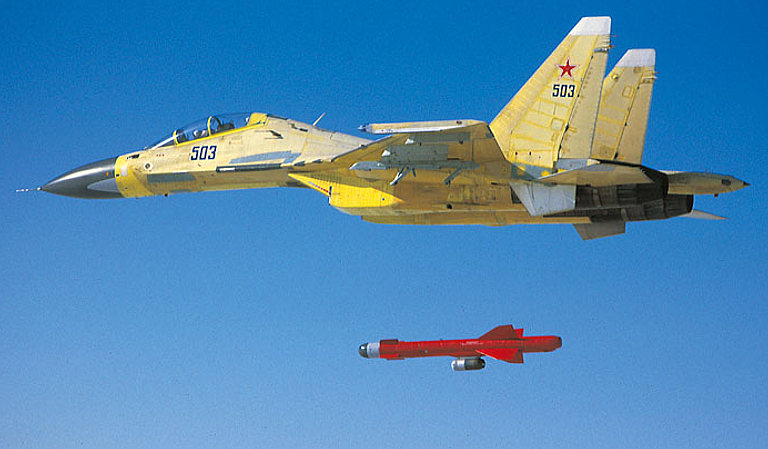
Su-30MK
Flanker G launching a Kh-59MK2 trials round. Note the deployed trapeze
launcher arms (KnAAPO image).
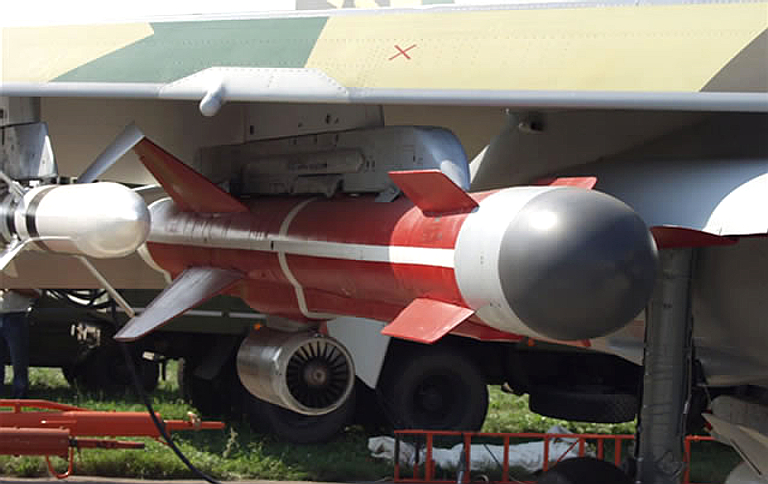
Su-35S
demonstrator with a Kh-59MK2 round (KnAAPO image).

Kh-59MK prototype for the PLA-N Su-30MK2, carried on an Su-24 Fencer.
References
- Многоцелевые
ракеты, KTRV, URI:
http://www.ktrv.ru/production/68/675/
- Противорадиолокационная ракета Х-58, URI: http://www.milrus.com/weapons/x58.shtml
- Х-58 (изделие 112 или Д7, AS-11 «Kilter»), УР «воздух-поверхность», URI: http://www.sergib.agava.ru/russia/raduga/kh/58/kh58.htm
- X-28, URI: http://www.airwar.ru/weapon/avz/x28.html
- Противорадиолокационная
ракета средней дальности Х-28, URI:
http://rbase.new-factoria.ru/missile/wobb/x28/x28.shtml
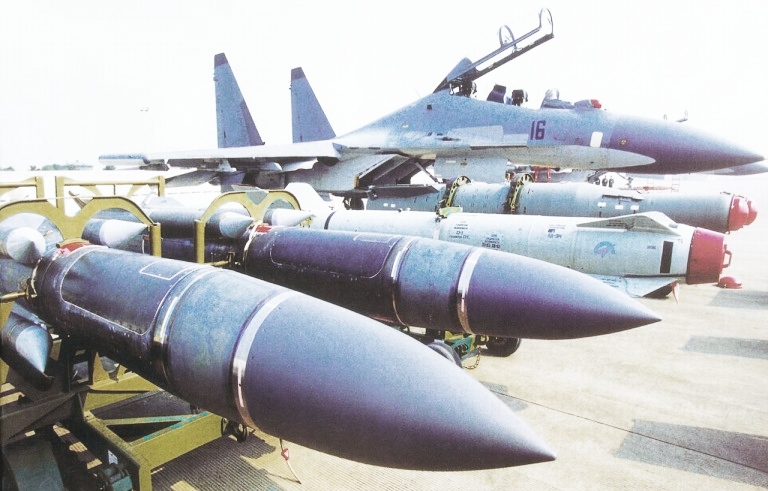

Imagery Sources: US DoD, Soviet MoD, PLA-N
Line Artwork: © 2000, 2007, 2008, 2009 Carlo Kopp
|
|||||||||||||
![Sukhoi PAK-FA and Flanker Index Page [Click for more ...]](APA/flanker.png) |
![F-35 Joint Strike Fighter Index Page [Click for more ...]](APA/jsf.png) |
![Weapons Technology Index Page [Click for more ...]](APA/weps.png) |
![News and Media Related Material Index Page [Click for more ...]](APA/media.png) |
||||||||||
![Surface to Air Missile Systems / Integrated Air Defence Systems Index Page [Click for more ...]](APA/sams-iads.png) |
![Ballistic Missiles and Missile Defence Page [Click for more ...]](APA/msls-bmd.png) |
![Air Power and National Military Strategy Index Page [Click for more ...]](APA/strategy.png) |
![Military Aviation Historical Topics Index Page [Click for more ...]](APA/history.png)
|
![Information Warfare / Operations and Electronic Warfare Index Page [Click for more ...]](APA/iw.png) |
![Systems and Basic Technology Index Page [Click for more ...]](APA/technology.png) |
![Related Links Index Page [Click for more ...]](APA/links.png) |
|||||||
![Homepage of Australia's First Online Journal Covering Air Power Issues (ISSN 1832-2433) [Click for more ...]](APA/apa-analyses.png) |
|||||||||||||
| Artwork, graphic design, layout and text © 2004 - 2014 Carlo Kopp; Text © 2004 - 2014 Peter Goon; All rights reserved. Recommended browsers. Contact webmaster. Site navigation hints. Current hot topics. | |||||||||||||
|
Site Update
Status:
$Revision: 1.753 $
Site History: Notices
and
Updates / NLA Pandora Archive
|
|||||||||||||
|
|
Tweet | Follow @APA_Updates | |||||||||||
|
|
|||||||||||||
|
|
|||||||||||||
![F-111 Aardvark Index Page [Click for more ...]](APA/f-111.png)
![F/A-18 Hornet and Super Hornet Index Page [Click for more ...]](APA/fa-18a.png)
![Aerial Refuelling and Airlift Capabilities Index Page [Click for more ...]](APA/aar-lift.png)
![Directed Energy Weapons and Electromagnetic Bombs Index Page [Click for more ...]](APA/dew.png)
![Notices and Updates Index Page [Click for more ...]](APA/notices-128.png)
![APA NOTAM and Media Release Index Page [Click for more ...]](APA/notams-128.png)
![APA Research Activities and Policy / Technical Reports Index [Click for more ...]](APA/research-128.png)
![Search Air Power Australia Website [Click for more ...]](APA/search-128.png)
![Briefings and Submissions - Air Power Australia [Click for more ...]](APA/briefs-128.png)
![Air Power Australia Contacts [Click for more ...]](APA/contacts-128.png)
![Funding Air Power Australia [Click for more ...]](APA/funding-258.png)
